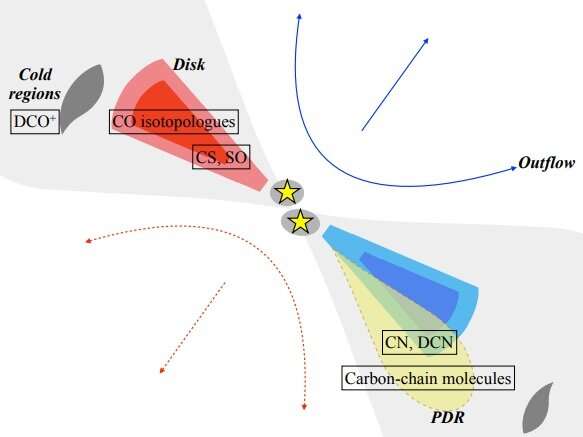June 10, 2019 report
Observations unveil chemical structure of the protoplanetary disk Oph-IRS 67

Using the Submillimeter Array (SMA), astronomers have conducted a molecular line study of the protoplanetary disk Oph-IRS 67, uncovering essential information about its chemical structure. Results of this study were presented in a paper published June 3 on the arXiv pre-print server.
Protoplanetary discs represent an important stage in the formation of planets. Astronomers believe that the final composition of planets depends on the chemical process taking place within the disc. Therefore, studies of the initial phase of disc formation could be crucial in improving knowledge of the formation and evolution of planetesimals, planets and other objects.
However, such studies are very challenging due to fact that the innermost regions of protoplanetary discs are embedded within large amount of gas and dust. In order to shed more light on the physical structure of these regions, chemical surveys of deeply embedded sources are required.
Oph-IRS 67 (IRS 67 for short) is a protobinary system located some 493 light years away in the Ophiuchus star-forming region and part of the L1689 cloud. The two sources in the system are separated by about 90 AU from each other.
Previous observations of IRS 67 have shown that it contains a Class I circumbinary disc with an extent of approximately 620 AU. In general, Class I discs represent the bridge between deeply embedded Class 0 sources and the emergence of planet-forming discs, known as Class II sources.
However, the researchers found that IRS 67 showcases a particular rich chemistry and bright emission of the c-C3H2 molecule, which is atypical for Class I sources. This unusual chemical composition motivated a trio of astronomers from University of Copenhagen, Denmark, led by Elizabeth Artur de la Villarmois, to investigate this disc in detail.
"The purpose of this paper is to explore the structure of a line-rich Class I protobinary source, Oph-IRS 67, and analyze the differences and similarities with Class 0 and Class II sources," the astronomers wrote.
Observations conducted using the SMA instrument allowed the team to detect a range of molecular transitions that trace different physics, such as carbon monoxide (CO) isotopologues, sulphur-bearing species, deuterated species, and carbon-chain molecules.
The researchers grouped the detected transitions into three main components: cold regions far from the system, the circumbinary disc, and a ultraviolet-irradiated region likely associated with the surface layers of the disc.
"The detected molecular transitions are tracing three main regions: cold regions beyond the circumbinary disc extent, the circumbinary disc, and a PDR [photon-dominated region] likely related with the surface layers of the disc. DCO+ is tracing the cold regions, while the CO isotopologues and the sulphur-bearing species are probing the disc structure," the paper reads.
Moreover, the study found that the continuum emission in IRS 67 is consistent with previous studies, which suggests that dust grains in the disc have grown to larger sizes than the interstellar medium dust particles, or that the dust is optically thick.
Summing up the results, the researchers concluded that IRS 67 exhibits chemical similarities with Class 0 sources, while photon-dominated region tracers, such as cyanide (CN), are associated with Class II discs. "IRS 67 is, therefore, a chemical link between these two stages," the scientists wrote.
More information: E. Artur de la Villarmois et al. Revealing the chemical structure of the Class I disc Oph-IRS 67, Astronomy & Astrophysics (2019). DOI: 10.1051/0004-6361/201935575
Revealing the chemical structure of the Class I disc Oph-IRS 67, arXiv:1906.00685v1 [astro-ph.SR]. arxiv.org/abs/1906.00685v1
Journal information: Astronomy & Astrophysics
© 2019 Science X Network





















